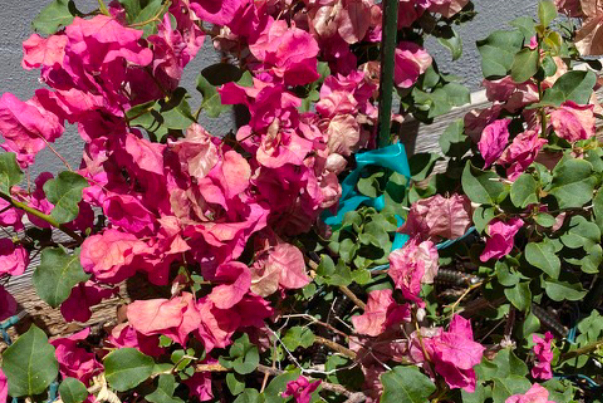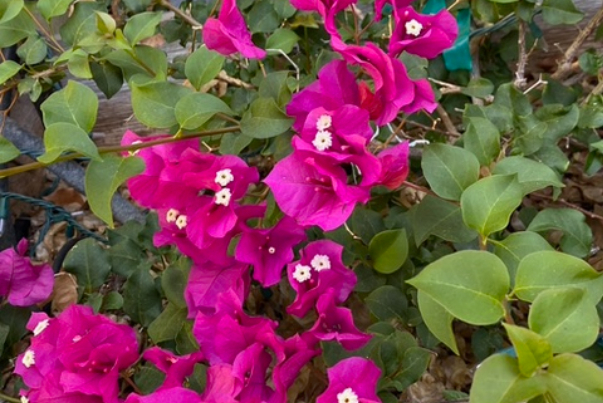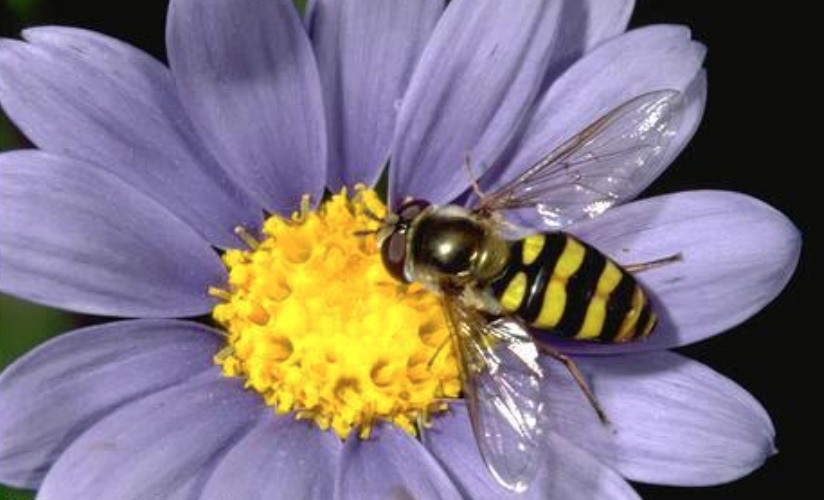Do you have a gardening question? The UC Master Gardeners of Santa Clara County can help. Our volunteers are part of the University of California’s Cooperative Extension program and we are trained to use research-based information to educate our fellow residents on sustainable gardening and landscaping practices specifically for our area.
Our monthly “Ask a Master Gardener” column will answer your questions and offer tips. Have a question? Email lifestyle@embarcaderopublishing.com or leave a comment at the end of this month's column.
What happened to my bougainvillea plant?
It was doing fine one day, but a week later it looked like this. Can you tell me what might be the cause? T.M. – San Jose
Answer: Water – either too much or not enough – is one of the most common problems we see with bougainvillea. A native of Brazil, this plant is drought tolerant and only wants water when it needs it. Too much water will make the roots soggy, causing them to rot as the plant’s leaves curl or turn yellow. Too little water makes the bougainvillea wilt and drop its leaves to conserve water. We suspect underwatering is the problem with your plant.
So how much water is enough? That depends on a few factors. When a plant is young and newly planted, its roots are close to the surface and dry out quickly, so frequent watering is best until it gets established. But once established, it needs only occasional – but deep – watering. Check the top few inches of soil around the plant and if it’s dry, it’s time for a good soak. This could be every five days or even every few weeks. That depends on the weather, the heat in the planting location and how well the soil drains.
Bougainvillea love heat and can handle temperatures over 100 degrees, but they do not like temperatures below 60 degrees. Cover outdoor plants and bring potted bougainvillea inside if frost is forecast. If it does become damaged by cold, it can usually be cut back and will regrow when the weather warms.
You can encourage new, fuller growth and blossoms by pruning to shape the plant and by pinching off the soft growing tips of young plants. Specialized fertilizers for bougainvillea that include iron and other micronutrients are available.
A happy note: After we evaluated this photo of the unhealthy bougainvillea, the questioner let us know that a few good soakings over a several weeks period revived the plant, and it’s doing well. Learn more about bougainvillea here.
..............................
How do I identify beneficial insects, and how do I attract them to my garden?
Answer: Most gardens contain far more beneficial insects than pest insects. There are pollinators, like bees and butterflies, which help plants produce fruit. Predators hunt, kill and eat insects. And parasites, like certain wasps, develop within a pest’s body and then kill them. Such drama!
The most common predators and parasites found in California gardens include:
• Lady beetles: Adults and larvae eat aphids.
• Lacewings: Larvae feed on many insect pests; you’ll often see adults around lights.
• Syrphid flies: Larvae eat aphids, and adults hover around flowers.
• Parasitic mini wasps: Many species of tiny wasps lay their eggs in pests such as aphids or caterpillars; their hatching larvae consume the pest and kill it.
• Spiders: All spiders feed on insects or other arthropods and are beneficial in the garden.
To identify insects, take pictures of them and any eggs or larvae (check the undersides of leaves). Then zoom in for a closer view and use this site to help you identify beneficial insects. Note that many insects look much different in their larvae stage than they do as adults.
Encourage beneficial insects by making your garden a welcoming place for them. Choose plants that provide them with pollen, nectar, and shelter and plant a variety of species that flower at different times of the year.
As much as possible, let predators and parasites – the natural enemies of pests - take care of pests in your garden. Find out which pests can be controlled by predators and parasites. Avoid using pesticides that can kill them, choosing instead the least toxic pesticides, which include horticultural oils and soaps.
..............................
What tips do you have for September gardening?
• Plant cool season vegetables now for winter and spring harvest. Peas are a particular star. By planting in September while the soil is still warm, peas will grow quickly and start to produce in two to three months, then continue into early spring.
• Consider saving the seeds of vegetables you loved this year for next year’s garden. The easiest seeds to save are from self-pollinating plants like beans, peppers, lettuce, and tomatoes.
• Monitor citrus trees for pests that can be present during the fall.
• Fall is the ideal time to inspect your garden tools. This site has tips for how to sharpen and clean tools.
Want to speak with a master gardener about a plant problem? UC Master Gardeners of Santa Clara County offers Plant Clinic Online, a monthly clinic held via Zoom that puts residents in touch with experts who can help diagnose their plant problems. Upcoming clinics are scheduled for 7 p.m. on Sept. 12 and Oct. 10. You can also submit questions to our Desk. Find more garden events and classes here.
San Mateo residents can also find gardening advice on the UC Master Gardeners of San Mateo and San Francisco website.




Comments